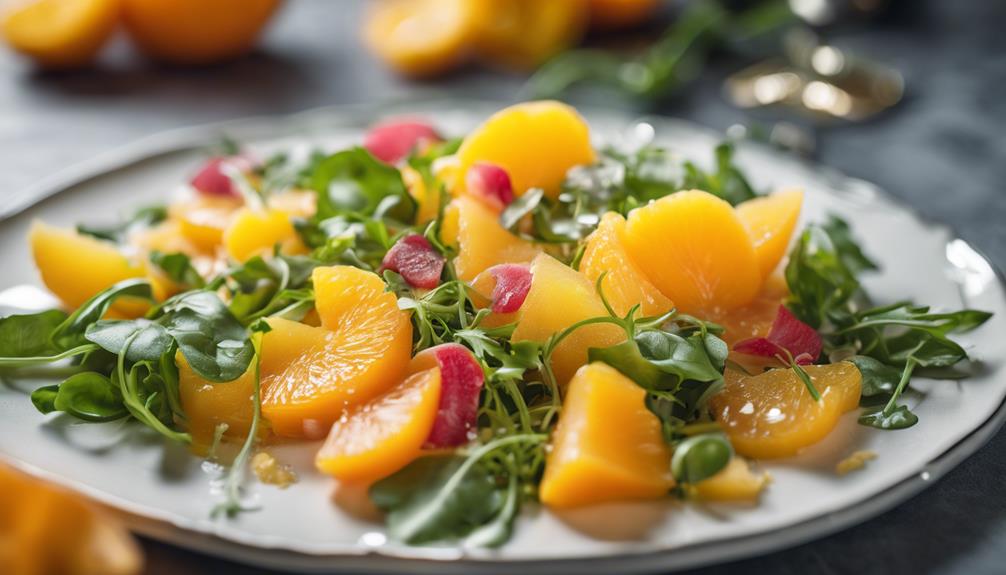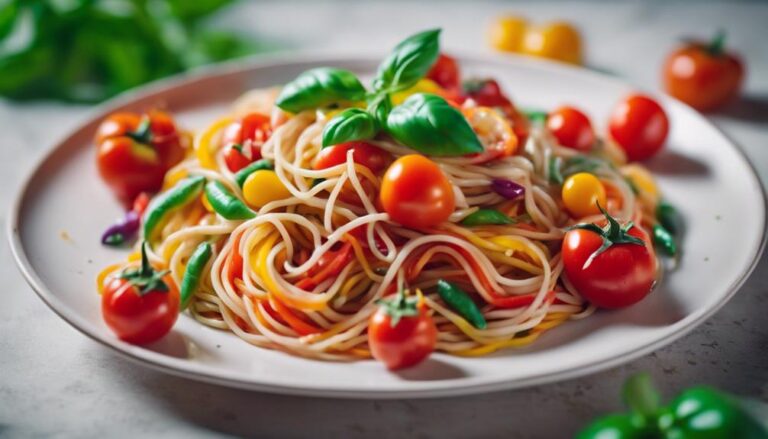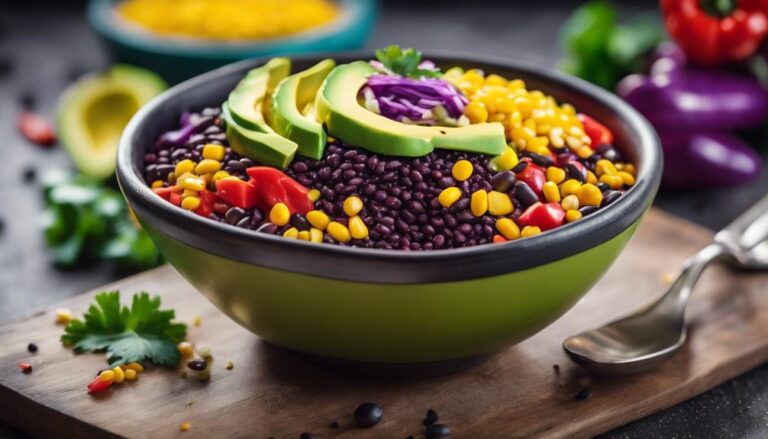Sous Vide Golden Beet and Citrus Salad
Immerse golden beets in a sous vide bath with citrus for a vibrant salad bursting with flavors. Seal beets and citrus with herbs or spices for an intensified taste experience. Sous vide precision preserves juices, textures, and enhances flavors. The earthy sweetness of beets harmonizes with zesty citrus in this elegant dish. Elevate your culinary creations with the sous vide method for a symphony of flavors.
What You Will Learn Here
- Sous vide preserves golden beets' natural flavors and nutrients.
- Citrus adds a refreshing contrast to the sweet beets.
- Vacuum-sealing with herbs and spices infuses rich flavors.
- Tender beets absorb marinades for enhanced taste.
- Sous vide ensures even cooking and intense flavor infusion.
Beet's Ancient Origins

Beets have a rich history, with ancient varieties cultivated for thousands of years. Their culinary significance spans various cultures and regions, showcasing the versatility and adaptability of this root vegetable.
Exploring the evolution of beets in cooking reveals the deep-rooted connection between food and human civilization.
Beet's Historical Roots
With a rich history dating back thousands of years, the ancient origins of the beet can be traced to various regions around the globe. Beets have held significant cultural symbolism and value in different societies throughout history. Ancient civilizations like the Greeks and Romans associated beets with various meanings. The vegetable was linked to Aphrodite, the Greek goddess of love, and was believed to enhance physical performance. On the other hand, Romans used beets not only for food but also for medicinal purposes due to their perceived health benefits and nutritional value. Beets were considered a source of strength and vitality.
In many cultures, beets were also used as a natural dye for fabrics and even cosmetics. Their vibrant red color made them a valuable commodity for creating colorful garments and makeup. The historical roots of beets go beyond culinary applications, showcasing their versatile nature and enduring relevance throughout the ages.
Ancient Beet Varieties
Tracing back to ancient times, the diverse range of beet varieties cultivated by early civilizations reflects the vegetable's rich historical significance and cultural importance. Beet breeding in ancient societies like the Egyptians, Greeks, and Romans led to the development of various beet cultivars, each with distinct characteristics and uses. These ancient varieties ranged in color from deep purple to golden hues, showcasing the early experimentation and selection processes that shaped the beets that are familiar today.
Beets held a prominent place in the diets of these ancient civilizations, with evidence of beet consumption found in culinary practices and medicinal applications. From the sweet, tender roots to the nutrient-rich greens, beets offered a versatile source of sustenance and flavor. Whether roasted, pickled, or consumed raw, ancient peoples valued beets for their culinary versatility and nutritional benefits. The enduring legacy of these ancient beet varieties continues to influence modern agriculture and cuisine, highlighting the enduring appeal and adaptability of this humble root vegetable.
Beet's Culinary Evolution
Exploring the ancient origins of beets reveals a rich tapestry of culinary evolution, weaving together history, culture, and agricultural innovation. Beets, with their vibrant hues and earthy flavors, have transcended time to offer not only a feast for the senses but also a plethora of health benefits. In ancient civilizations, beets weren't only a culinary staple but also held cultural significance, symbolizing love and vitality. Over time, these humble root vegetables have undergone a remarkable transformation in the culinary world, inspiring culinary creativity and modern adaptations.
The beet's health benefits, such as being rich in essential nutrients and antioxidants, have contributed to its enduring popularity in various cuisines. From traditional borscht in Eastern Europe to trendy beet salads in modern restaurants, the beet has proven its versatility in the kitchen. Its deep-rooted cultural significance has paved the way for innovative dishes like beet carpaccio and beet hummus, showcasing the beet's adaptability to contemporary palates. Embracing the beet's culinary journey reveals a fascinating blend of tradition and innovation, making it a star ingredient in the ever-evolving world of gastronomy.
Beet's Flavorful Companions
Enhance the earthy sweetness of golden beets with zesty citrus fruits and aromatic herbs. When it comes to creating a vital dish, the combination of flavors plays a significant role.
Here are some flavorful companions that can elevate the taste of your golden beet salad:
- Citrus Pairing: The tangy brightness of oranges or grapefruits can complement the sweet undertones of golden beets, creating an invigorating flavor profile.
- Herbaceous Additions: Fresh mint or basil can add a burst of freshness to your salad, enhancing the overall herbaceous notes and providing a contrast to the earthiness of the beets.
- Nutty Crunch: Adding toasted walnuts or almonds can introduce a delightful crunch to your salad while also bringing in a nutty richness that pairs well with the beets.
- Creamy Avocado: Slices of creamy avocado can add a smooth texture to your salad, balancing out the flavors and adding a touch of richness to each bite.
Beet and Goat Cheese Salad
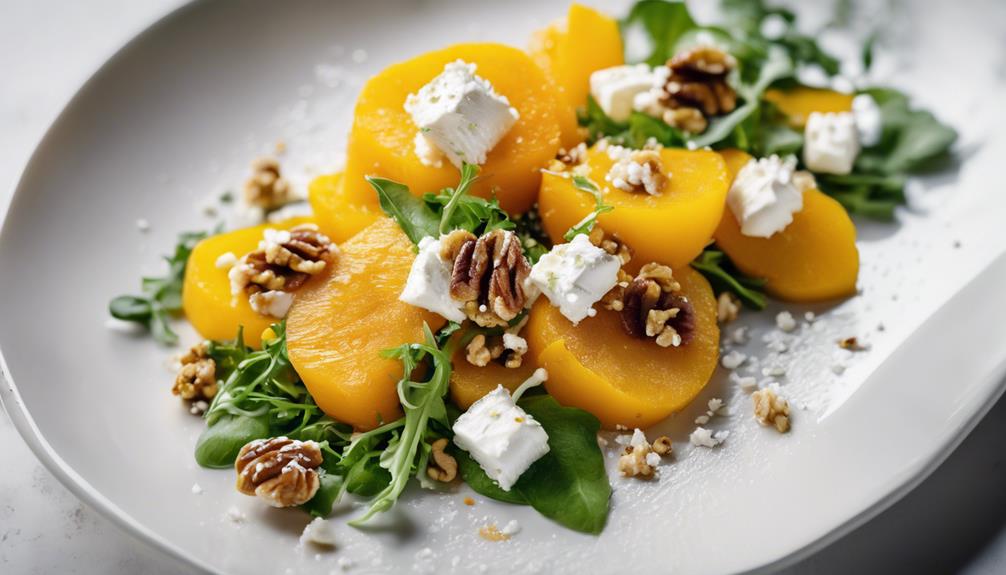
When making a Beet and Goat Cheese Salad, you can explore a variety of delicious combinations like the Golden Beet Salad Recipe, Beet and Arugula Salad, and Beet and Feta Salad. These options offer a range of flavors and textures that complement the earthy sweetness of beets with the tangy creaminess of goat cheese.
Try experimenting with different ingredients to create a unique and flavorful salad that suits your taste preferences.
Golden Beet Salad Recipe
To enjoy a delightful combination of flavors and textures, try making this Golden Beet and Goat Cheese Salad. This recipe offers a vibrant and nutritious dish that's sure to impress your taste buds and your guests. Here are some reasons why this salad is a must-try:
- Colorful presentation: The bright golden beets paired with the creamy white goat cheese create a visually stunning dish that will make your table pop with color.
- Nutrient-rich ingredients: Golden beets are packed with essential nutrients like fiber, vitamin C, and potassium, while goat cheese adds a rich source of protein and calcium, making this salad not only delicious but also nutritious.
- Contrasting textures: The tender roasted golden beets combined with the creamy goat cheese create a wonderful contrast in textures that will keep you coming back for more.
- Balanced flavors: The earthy sweetness of the beets paired with the tangy creaminess of the goat cheese and a drizzle of balsamic glaze create a perfectly balanced flavor profile that will tantalize your taste buds.
Beet and Arugula Salad
For a delightful combination of flavors and textures, consider trying the Beet and Arugula Salad, also known as the Beet and Goat Cheese Salad. This salad brings together the earthy sweetness of beets, the peppery bite of arugula, and the creamy tang of goat cheese for a truly satisfying dish. Adding quinoa to the mix provides a hearty element that complements the other ingredients perfectly. The invigorating burst of grapefruit cuts through the richness of the goat cheese, creating a well-balanced and invigorating salad that's both nutritious and delicious.
- Experience the vibrant colors and fresh flavors dancing on your taste buds
- Indulge in the creamy goodness of goat cheese paired with tender beets
- Savor the peppery kick of arugula mingling with the citrusy brightness of grapefruit
- Enjoy a hearty and wholesome meal with the addition of protein-packed quinoa
This Beet and Arugula Salad is a fantastic option for a light lunch or a flavorful side dish at dinner. Give it a try and treat yourself to a symphony of tastes in every bite.
Beet and Feta Salad
Explore the savory combination of tender beets, creamy goat cheese, and now, tangy feta in the vibrant and satisfying Beet and Feta Salad. This dish combines the earthy sweetness of beets with the rich creaminess of feta for a delightful culinary experience. As you savor each bite, let the flavors dance on your taste buds, creating a symphony of taste and texture. The Beet and Feta Salad is a perfect harmony of flavors that will leave you craving more.
Unordered bullet list:
- The salty tang of the feta pairs perfectly with the sweetness of the beets, creating a delicious contrast in every mouthful.
- Using seasonal ingredients guarantees the freshness and quality of the salad, enhancing its overall taste and appeal.
- The creamy texture of the goat cheese complements the tender beets, adding a luxurious touch to this simple yet elegant dish.
- Each bite of the Beet and Feta Salad is a delightful journey through layers of flavor, making it a must-try for any food enthusiast.
Beet Cooking Techniques
When it comes to cooking beets, you have a choice between roasting and boiling. Each method offers its unique advantages, with roasting often enhancing the natural sweetness of the beets.
Additionally, sous vide cooking can be a game-changer, allowing for precise temperature control and flavor infusion opportunities.
Roasting Vs Boiling
Consider your preferred method of cooking beets, whether roasting or boiling, to achieve the desired texture and flavor in your dishes.
Roasting beets intensifies their natural sweetness and enhances their earthy flavor, making them a popular choice for salads and side dishes. The process involves wrapping the beets in foil with a drizzle of olive oil and seasoning, then baking them until tender. This method results in a slightly caramelized exterior and a creamy interior, perfect for adding depth to your dishes.
On the other hand, boiling beets is a quicker method that helps retain their vibrant color and nutrients. Simply place the beets in a pot of boiling water until they're fork-tender. This technique is ideal for dishes where you want the beets to maintain a firmer texture.
Whether you choose roasting or boiling, both methods can elevate the flavor profile of your dishes and provide a versatile ingredient for various culinary creations.
Sous Vide Benefits
To enhance the texture and flavor of your beets, utilizing sous vide cooking techniques can provide precise control over the cooking process while maintaining the natural essence of the vegetable.
Temperature control is a key benefit of sous vide cooking for beets. By cooking the beets at a controlled and consistent temperature in a water bath, you can guarantee that they're perfectly cooked throughout without risk of overcooking. This method also helps in retaining the texture of the beets, keeping them tender yet firm, unlike boiling which can sometimes make them mushy.
Texture retention is another advantage of sous vide cooking for beets. The vacuum-sealed bags used in sous vide cooking help the beets retain their natural juices and flavors, resulting in a more intense taste experience. Additionally, the slow, gentle cooking process allows the beets to fully absorb any seasonings or marinades you add to the bag, enhancing their overall flavor profile.
Sous vide cooking is a great way to elevate the taste and texture of your beets while maintaining their natural goodness intact.
Flavor Infusion Techniques
Enhance the depth of flavor in your beet dishes by exploring innovative infusion techniques that take your cooking to the next level. When it comes to flavor infusion and modern methods for beet cooking, sous vide stands out as a culinary innovation that can elevate your dishes.
Sous vide, a cooking technique that involves vacuum-sealing food in a bag and cooking it in a water bath at a precise temperature, is perfect for infusing beets with a variety of flavors.
One modern method for flavor infusion using sous vide is to vacuum-seal peeled and sliced beets with herbs, spices, citrus zest, or even a splash of balsamic vinegar before cooking them in the water bath. This technique allows the beets to absorb the flavors intensely, resulting in a more complex and delicious taste profile.
Additionally, sous vide guarantees that the beets are evenly cooked to the desired doneness, retaining their natural sweetness and vibrant color throughout the process. Experimenting with sous vide for beet cooking can open up a world of flavor possibilities and elevate your culinary creations to new heights.
Final Thoughts
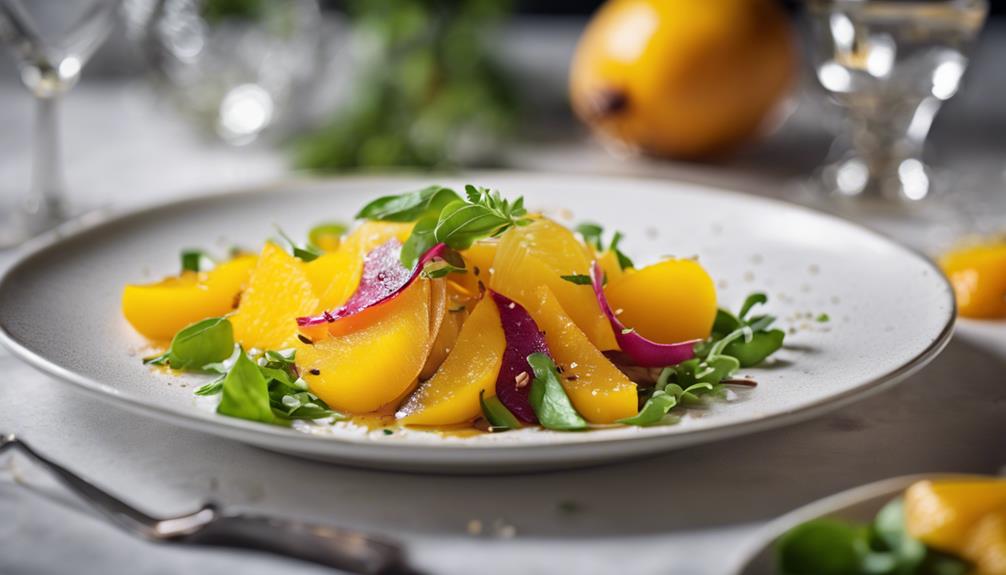
As we conclude our exploration of this Golden Beet and Citrus Salad, reflect on the vibrant flavors and textures that have come together in a delightful harmony. The sous vide advantages truly shine in this dish, allowing the beets to retain their natural sweetness and earthy undertones while ensuring a perfect tender-crisp texture. When compared to traditional cooking methods, the sous vide technique elevates the taste and texture of the ingredients, resulting in a more vibrant and flavorful salad experience.
Pairing the sous vide golden beets with the bright citrus segments creates a beautiful balance of sweet and tangy flavors. The earthiness of the beets complements the citrusy notes, enhancing the overall flavor profile of the salad. This combination not only delights the taste buds but also offers a visually appealing dish with its vibrant colors and textures.
Incorporating ingredient pairings that complement each other's flavor profiles is key to creating a well-rounded and satisfying salad. The sous vide golden beets and citrus segments not only work harmoniously together but also showcase the versatility of sous vide cooking in enhancing the natural flavors of the ingredients.
Frequently Asked Questions
Can Golden Beets Be Substituted With Red Beets in the Salad?
Yes, red beets can be substituted for golden beets in the salad. While both beet varieties offer earthy flavors, red beets tend to have a slightly stronger taste and more vibrant color, which can complement the citrus elements in the dish.
Is It Necessary to Peel the Golden Beets Before Cooking?
When debating the peeling of golden beets, consider the flavor impact. Peeling can enhance the taste by removing earthy notes. However, leaving the skin on can provide a more robust flavor profile. Experiment to find your preference.
How Long Can the Sous Vide Golden Beets Be Stored in the Fridge?
To keep your sous vide golden beets fresh in the fridge, store them properly. Refrigerate them in an airtight container for up to 5 days. This preserves their flavor and texture, ensuring they stay delicious for a few days.
Can Other Types of Citrus Fruits Be Used in the Salad?
Yes, you can use different citrus fruits in the salad. Grapefruit and lime are great choices. Consider pairings like blood orange and lemon for unique flavors that complement the beets beautifully. Experiment and find your favorite combination!
Are There Any Recommended Variations for the Dressing in the Salad?
When exploring flavor combinations, consider trying different dressings like balsamic vinaigrette or honey mustard for a unique twist. Experiment with ingredient substitutions such as using different types of vinegar or citrus fruits. Get creative with presentation ideas to showcase the vibrant colors.
Conclusion
To sum up, rejuvenating sous vide cooking offers a unique and flavorful way to enjoy golden beets in a citrus salad. By combining the earthy sweetness of the beets with the bright acidity of citrus fruits, you create a dish that's both invigorating and satisfying.
With the addition of goat cheese for a creamy touch, this salad is sure to impress your taste buds. So, next time you're looking for a vibrant and delicious salad option, consider giving this sous vide golden beet and citrus salad a try.
